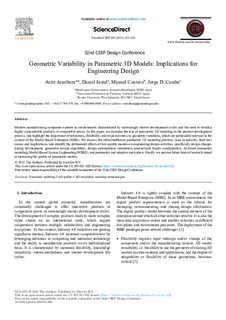
Title
Geometric Variability in Parametric 3D Models: Implications for Engineering DesignPublication Date
2022Other institutions
Universitat Politècnica de València (UPV)Purdue University
Version
Published versionDocument type
Conference ObjectConference ObjectLanguage
EnglishRights
© 2022 The AuthorsAccess
Open accessPublisher’s version
https://doi.org/10.1016/j.procir.2022.05.266Published at
Procedia CIRP. Vol. 109. Pp. 383-388, 2021Publisher
ElsevierKeywords
Parametric modelingCAD quality
CAD reusability
modeling methodologies
Abstract
Modern manufacturing companies operate in environments characterized by increasingly shorter development cycles and the need to develop highly customizable products at competitive prices. In this pape ... [+]
Modern manufacturing companies operate in environments characterized by increasingly shorter development cycles and the need to develop highly customizable products at competitive prices. In this paper, we examine the role of parametric 3D modeling in the product development process, and highlight the importance of robustness, flexibility, and responsiveness to geometric variations, which are particularly relevant in the context of the Model-Based Enterprise (MBE). We discuss the often-inefficient parametric 3D modeling practices used in industry, their root causes and implications, and identify the detrimental effects of low-quality models on engineering design activities, specifically design changes during development, generative design algorithms, design optimization, simulation, product/part family configuration, AI-based parametric modeling, Model-Based System Engineering (MBSE), and parametric and adaptive encryption. Finally, we present future lines of research aimed at increasing the quality of parametric models. [-]
Collections
The following license files are associated with this item:





















